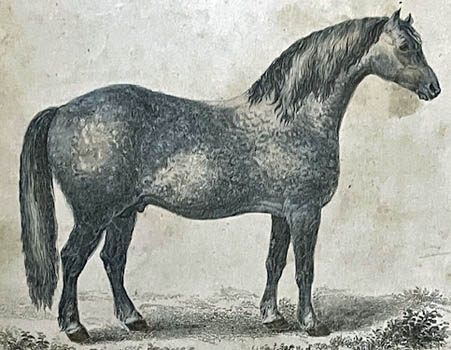So, You Think You Love Horses?
Some Reflections on the Nature of Horses and Man
Glossary of Equestrian Terms
Words Beginning with L
-
Lady's Basket (Ladies' Phaeton or Basket Phaeton)
Lady's Basket

|
[Carriage Type] A lady's basket was a type of open, two-horse, four-wheeled carriage. They were driven almost exclusively by women and were popular vehicles at resorts, parks and beaches.
-
Lameness
[Veterinary Medicine] Lameness is described as a sudden change in a horse’s gait. Mostly it is recognized when a horse is limping or when a rider mounts and notices that the horse is not moving out well. The causes of lameness are legion, but fortunately most of the common causes are minor and self limited. If you own a horse or ride one, it is a safe bet that at some point, it will come up lame. Many times this occurrence has been a source of disappointment to me personally. There are those riders who keep a second horse as a hedge against missing an important event due to a lame horse. I would advise, any rider if you believe your horse might be lame; for heavens sake, stop immediately and do not ride him. We usually call a veterinarian, but with mild lameness initial watchful waiting is not inappropriate.
-
Laminae
[Equine Anatomy] The laminae are key structures within a horse's hooves that interlock the distal phalanx of the 3rd digit (coffin bone) to the inside of the hoof wall.
-
Laminitis
[Veterinary Medicine] Laminitis is the inflammation and separation of the laminae. Chronic severe laminitis is founder. There are multiple causes, prevention strategies and treatment options.
-
Landau Carriage
[Driving] A Landau is four-wheeled luxury carriage with a cover that can be let down.
-
Lark
[Fox Chasing] Member of the field, who unnecessarily jump fences or otherwise move around while the hunt is in progress, are said to be off on a lark. The practice is particularly frowned upon and not just a venial sin.
-
Lateral Gait
[Equine Gait] A lateral gait is one in which the horse's two legs on the same side move together. A pace is an example.
-
Lateral Movement
[Equine Gait] A lateral movement is one in which the horse moves forward and also to one or the other side.
-
Lateral Patellar Luxation
[Veterinary Medicine] Congenital lateral patellar luxation is an outward displacement of the patella (knee cap) present at birth. Surgical management is generally successful.
-
Lateral Recumbency
[Equine Position] A horse in a pose of lateral recumbency is lying on the ground on one of its sides. Horses often do this when sleeping or resting. The other recumbent position is on their chest and abdomen with legs folded and is called sternal recumbency.
-
Latigo
[Equine Equipage] A latigo is a one-and-a-half to two-inch strap that is attached to the froward part of a western saddle at a latigo hanger. The strap has a series of holes at the end that are secured by a cinch buckle on the cinch. The cinch holds the saddle to the horse's body and the latigo adjusts the tightness of the fit.
-
Lead
[Equine Gait] At a canter, lope or gallop the foreleg sweeping forward last in the canter stride sequence defines the particular lead (right or left) that he horse is on. The canter sequence starts with the outside back leg (leg nearest to the wall or fence). On the straight it does not matter. However, if the horse is moving around a ring counter-clockwise, it should be on left lead, while if clockwise it should be the right lead. There are signals that a rider gives to the horse regarding which lead is called for. Being on the correct lead maintains correct balance and stride, so this is not just an academic exercise. It can be dangerous if you turn a corner too sharply on the wrong lead since it throws the rider and horse off balance and might result in a fall. When a horse spontaneously runs it will mostly be on the same lead. An individual horse may be naturally right leaded or left leaded, just as people might be right or left handed.
-
Lead Change
[Equine Gaits] A lead changes are something done spontaneously by horses, either running by itself or while ridden. Since these are natural to a horse they do not need to be trained to do them. What needs to be taught to the rider is how to ask for a lead change and then have the horse understand that the series of signals indicates a lead change. Inexperienced riders tend to have a little anxiety about timing and executing the sequence. The basic moves for the rider is to press the inside leg against the while simultaneously turning your head and reins slightly in the direction of the desired lead change. The horse then horse to step over with the opposite foreleg and goes over onto the new lead.
-
Lead Change in Horse Racing (Special Case)
[Horse Racing] Horses race around a track counter-clockwise, and the great majority are on the appropriate left lead while in the turns. However, most are also taught while on the finial straight stretch to do a difficult switch to their right lead at full speed. The horses able to execute the change well have a competitive advantage. It is easy to see a dressage horse do a lead change. With a racehorse this all happens in the blink of an eye and most observers are unaware of it.
-
Leadline Class
[Horse Show Category] Leadline classes were traditionally included in horse shows as a young child's introduction to showing in a ring. The event was noncompetitive and there was a ribbon for all. More recently a second kind of competitive leadline class has come into being and this one attempts to judge the entries competitively. An adult should investigate the event and decide which type the show is and what kind would be in the child's best interest. During the show an adult holds the pony with a leadline. Generally, the child will be holding reins. A brief trot may be requested. Dress requirements will vary according to the rules of the show.
-
Leading Rein (Opening Rein)
[Basic Horsemanship] An leading rein is done when the rider is turning the horse. The rider moves the inside rein out to the side of the horse's shoulder and in the direction of the turn, maintaining a steady contact with the other outside rein and a slight pressure with the inside leg aids to support the turn. I always add a very slight tug and release on the inside rein to focus the horse's attention just as I begin doing it.
-
Lead Pony
[Horse Racing] A lead pony and its rider conducts a race horse from the paddock to post by walking along side of it.
-
Leg Up
[Horse Mounting Method] When a person on the ground helps boost a rider into the saddle it is reference to as a leg up. It is particularly useful when short people need to mount tall horses.
-
Levade
[Dressage] The levade is a classical dressage exhibitionary movement in which the horse stands on bent hind legs with its body at about 35 degrees to the perpendicular. This pose is only held for seconds but requires much training and strength on the part of the horse. It might be done with or without a mounted rider. This can be seen during exhibitions by the Spanish Riding School of Vienna but is not commonly done by ordinary dressage riders, given its difficulty and the strain placed on the horse. My gray did very nice levades when we would try to load him on a trailer.
-
Leverage Bit (Curb Bit)
Leverage Bit
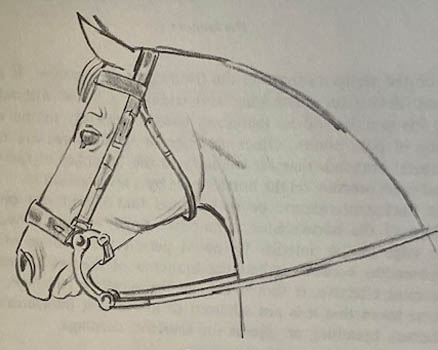
|
[Equine Equipage] A leverage bit is designed to exert pressure on the horse's mouth and chin via a chain under the chin. Most leverage bits are worked with a single rein. The mouth piece may or may not be hinged and attaches to a pair of shanks on either side. These shanks are metal pieces that extend to a pair of rings on either end. One set is attached to the reins and on the other end of the shank are rings that attach to the headstall. The level action is provided by the separation. In addition, a curb chain or leather strap passes under the horse's chin and provides additional pressure. Most classical Western bits are of this type. When viewing a horse with any kind of leverage bit you have the impression that parts of the bit are hanging down from the horse's mouth when the rider has the reins loose. When the reins are pulled back you see the shanks rotate upwards. With a snaffle type non-leverage bit you see only the single ring at the mouth. There are hybrids that have both a leverage and snaffle features. Many riders feel that leverage bits are not for novice riders and may be unnecessary in most horses, who do find with snaffle bits.
-
Lever Arm
[Equine Equipage] The lever arm is the longer arm of a curb bit shank that runs from the mouth piece to the lower rein ring. The shorter arm is called the purchase.
-
Life Guards
A Life Guard and Mount
(from Wikimedia Commons in public domain)
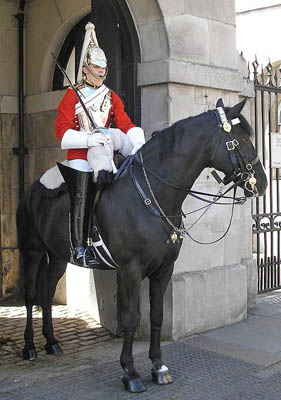
|
[Military] The Life Guards are the senior the cavalry regiment of the British Army, part of the Household Cavalry. The regiment maintains a mounted troop, which conducts a colorful mounted changing of the guard ceremony in the courtyard in front of the Horse Guards building.(facing Whitehall). This ceremony is less well-know than the foot ceremony at Buckingham place but is a must see by any horse lover when visiting London. You are likely to get a front row seat without the mass of usual tourists. They wear a scarlet tunic, a metal cuirass and a matching helmet with a white plume.
-
Light Brigade
Charge of the Light Brigade 1854
Courtesy: Willimedia Commons

|
[Military] The famous charge of the Light Brigade was a British military debacle that occurred during the October 25, 1854 Battle of Balaclava during the Crimean War and the subject of a poem by Alfred, Lord Tennyson. Due to a confusion of orders, several regiment of British cavalry made a suicidal attack against an artillery position that had been recently captured by the enemy. The attack was gamely carried out, unsuccessful and the resulting casualties heavy.
-
Light Cavalry
[Military] Light cavalry were a class of cavalry units intended to function for scouting, escorting, skirmishing, screening, foraging and acting as couriers but not as a main battle element. Cavalry in the Americas were for the most type of this type.
-
Light Harness Rig
[Driving] A light harness rig is suitable for driving light weight vehicles. It employs a breast plate and crupper straps to pull the load.
-
Light Seat
A Rider (Me) at a Halt Exhibiting the Light Seat
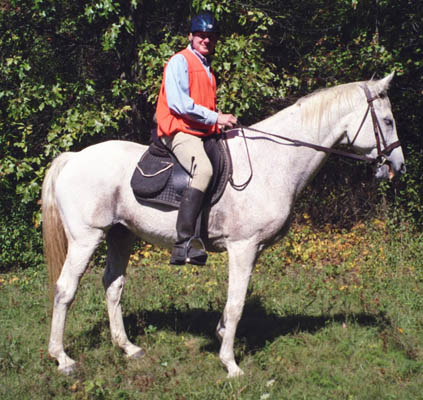
|
[Basic Riding Positions] The light seat is one of three principle riding seats (rider's positions in the saddle) and the one most commonly used. Many riders are not even aware of it having a name, but naturally develop it when learning to ride. This position is intermediate between the forward leaning (hunter or jumping) seat and the slightly backward (dressage or classical) seat and only slightly forwards. The name comes from the fact that the position is very light on the horses back and spine. The knees are somewhat bent with the stirrups worn two holes shorter than one might for the dressage seat in which the leg is relatively straight. While balanced in his seat position the rider’s weight should be carried by his thighs and knees. The rider is seated in the saddle, but does not carry his weight in the saddle. A beginning rider who allows his lower legs to slip backwards of the center of gravity will quickly notice that all balance is lost and a fall possible. In this position hands are held still and just above neck with the reins, the back of the hand, the lower arm forming one straight line. This is much different than in Western riding. A veteran English rider automatically does all these things, but for the beginner they all must the learned and practiced.
-
Limited Distance Ride
[Equine Event] Categories of beginner endurance trail riding competitions are defined in terms of a limited distance, starting at 25 or 35 miles achieved in a prescribed period of time. Advanced competitions are set at 50 or 100 miles. The limited rides allow horse and rider to discover if they can truly go the distance.
-
Line
[Fox Chasing] The line is the scent trail of the fox that the hounds are following.
-
Line of the Ball
[Polo] The line of the ball is the imaginary line along which the ball is traveling and represents a right of way for the player following nearest the line. There are strict rules governing opponents entry into this right of way, in order to minimize the risk of collisions. The most frequent foul occurring in polo is crossing the line.
-
Line Up
[Horse Showing] At the end of a class the judge directs the competitors to enter the ring and stand together in a line facing the judge. At that point the results are announced.
-
Long Pastern Bone (Suffraginis Bone or Proximal Phalanx)
[Equine Anatomy] The long pastern bone is located between the fetlock and pastern joint. The long pastern bone articulates with the cannon bone above it and the short pastern bone below it. The function of the long pastern bone is to increase the flexibility of the fetlock joint and reduce concussion. The length, flexibility, and slope of the pasterns has an effect on the smoothness of the horse’s gait.
-
Long Takeoff Point
[Equestrian Jumping] With a long takeoff point the horse leaves the ground too far from the optimum spot to make the jump. An athletic horse will usually carry over the obstacle, but it is awkward and uncomfortable and "usually" has its unfortunate exceptions. It is the result of poor coordination between the horse and rider.
-
Lipizzaner
Lipizzaner Stallion
(Courtesy: Wikipedia and "Machoxx")
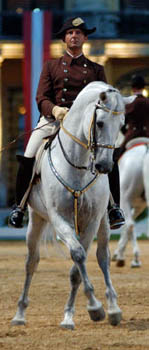
|
[Equine Breed] Lipizzaners are a breed of horses established under the patronage of the Hapsburg dynasty of the Austro-Hungarian Empire. The name comes from the original stud farm at Lipica in Slovenia. They are the breed employed by Spanish Riding School of Vienna, Austria and are exhibited preforming the difficult haute école (high school) movements of classical dressage. Although adult Lipizzaners are generally gray in color, like other grays they are born bay or black and lighten as they age. Lipizzaners are muscular, mature slowly and live relatively long lives. These are good traits to have in that classical dressage requires a long training period and a strong animal to master.
-
Long-Coupled
[Equine Body Type] The term long-coupled refers to a horse with a relatively longer back that typical of other horses. Certain breeds are characteristically long-coupled, such as the Thoroughbred, where a longer back contributes to longer strides better for racing. Many riders prefer short-coupled horses, such as Arabians or Quarter Horses, with the idea they are more maneuverable and quick during show jumping, barrel racing or cutting. Short-coupled horses are generally believed to be much more successful in bucking their riders off than long-coupled ones. Long-coupled horses may be more likely to suffer soft tissue back trauma.
-
Long Reining
[Schooling] Long reining is a schooling technique in which the horse is controlled by a pair of long reins (often lunge lines) passed through a special training surcingle (also called a roller) on the horse's body or a saddle's stirrup leathers, hanging just below the flap and then attached to a bridle less its normal reins. The horse is worked using voice commands and signals via the reins. Long reining more closely simulates the experience of aids for the horse but without a rider on its back. The trainer is at a distance behind the horse, often over 9 feet and standing slightly to the side, so as not to be in the horse's blind spot. If done for the first time, it would be good to get instruction in using the technique from a person experienced with it. .
-
Loose Ring Jointed Snaffle Bit
Loose Ring Jointed Snaffle Bit
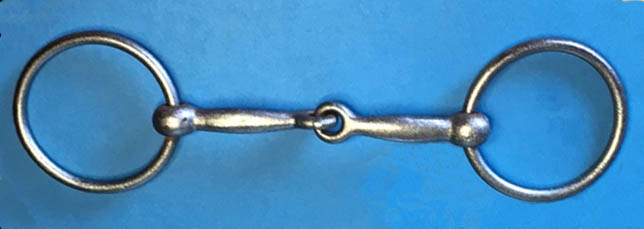
|
[Equine Equipage] A loose ring jointed snaffle bit is a single jointed, non-leverage bit ending in loose rings that hold the reins. It has a mild pinching and gagging action when applied.
-
Lope
[Equine Gait] The term lope denotes a type of slow canter that is preferred in western style riding. It is easy on the horse over longer distances and allows the rider to sit comfortably down in the saddle, something more difficult to sustain during faster canters.
-
Lungeing
[Ground Work] Lungeing refers to exercising a horse in a wide circle without a rider and while attached to a long line. The horse has a special type of halter on its head, called a lungeing cavesson. The horse is impelled by the human's voice, body movements and the use of a special lunge whip, which mostly does not touch the animal.. You should never actually whip a horse. Lungeing is much more difficult to do in practice than you might think. I found I needed to receive instruction from a trainer in lungeing techniques. My horse had a tendency to come straight to me and stand there rather than proceed around the circle as it should and thereby defeat the purpose of the exercise. You not only need to know basic technique but also have a clear sense of what you are trying to teach the animal doing it. Any kind of training can sour an animal if not properly done with clear goals and a cut off point in mind.
-
Lusitano
Lusitano Head (courtesy Wikipedia)

|
[Equine Breed] Lusitanos are Portuguese horse breed. They were originally bred as warhorses by crossing Arabians with an older local war horse breed. They are very closely related to Andalusians. Breed characteristics include: narrow heads with profiles that are slightly convex, thick and arched necks, deep, broad chests, short, strong backs and thick manes and tails.
-
Lyme Disease
[Veterinary Medicine] Lyme disease is a tick-borne disease caused by the spirochete bacterium, Borrelia burgdorferii. Borrelia antibodies are not uncommon in the blood of horses in Lyme endemic areas, since high grass and other vegetation is also a home to ticks. However, what is often less clear is the relationship between a given perceived symptom and the presence of antibodies to the Lyme organism in horses' blood. The situation is entirely analogous to the existence of certain symptoms experienced by humans with chronic Lyme disease symptoms. Many physicians doubt that these symptoms have a basis in the previously treated more acute disease. Because Lyme symptoms are often insidious, can a veterinarian be certain Lyme is the cause of vague lameness or a lack of energy or might it be the usual lameness or just aging? In the end it is a judgement call and certainly a course antibiotics might be given for a presumptive diagnosis.
Glossary of Equestrian Terms: Main Alphabetical Listing
Links to Other Sites with Equestrian Interests
Back to Introduction
